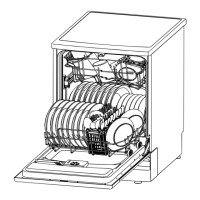6
1
Cups
2
Glasses
Saucers
3
For best performance of the dishwasher, follow these loading guidelines. Features and
appearance of racks and silverware baskets may vary from your model.
Scrape off any large amounts of leftover food. It is not necessary to rinse the dishes under running water. Place objects in the
dishwasher in following way:
1.Items such as cups, glasses, pots/pans, etc. are stood upside down.
2.Curve items, or those with recesses, should be at a slant so that water can run off.
3.They are stacked securely and can not tip over.
4.They do not prevent the spray arms from rotating while washing takes place.
Very small items should not be washed in the dishwasher as they could easily falloutoftheracks.
To prevent water dripping from the upper back into the lower back, we recommend that you empty the lower basket first and then
the upper ack.
The upper rack is designed to hold more delicate and lighter dishware such as glasses, coffee and tea cup and saucers, as well as
plates, small bowls and shallow pans (as long as they are not too dirty). Position the dishes and cookware so that they do not get
movedbythesprayofwater.
Attention before or after Loading the Dishwasher Racks
Removing the Dishes
Loading the Upper Rack
r
Adjusting the Upper Rack
If required, the height of the upper rack can be adjusted in order to create more space for large utensils either in the upper rack or
lower rack. The upper rack can be adjusted for height by putting wheels of different height into the rails. Long items, serving cutlery,
salad servers or knives should be placed on the shelf so that they do not obstruct the rotation of the spray arms. The shelf can be folded
back or removed when not required for use.

